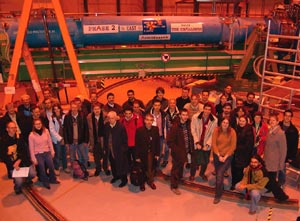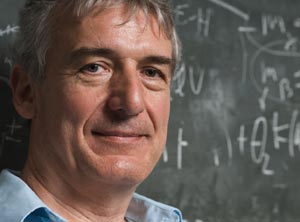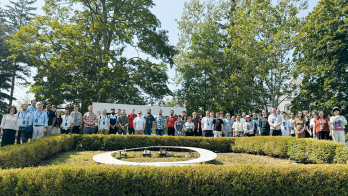Konstantin Zioutas reports on the first Joint ILIAS-CAST-CERN Axion Training workshops, which covered a wide range of studies, from experiments at nuclear reactors to investigations of the roles of axions in solar physics and cosmology.
One of the biggest mysteries of science is the nature of dark matter, which first became apparent as astronomer Fritz Zwicky’s “dunkle Materie” in 1933. The two leading particle candidates for this “missing matter” are weakly interacting massive particles (WIMPs) and axions – hypothesized uncharged particles that have a very small but unknown mass, which barely interact with other particles. To bring together the widespread axion community, the Integrated Large Infrastructure for Astroparticle Science (ILIAS), the CERN Axion Solar Telescope (CAST) collaboration and CERN have organized a series of training workshops on current axion research, including open discussions between theorists and experimentalists. The first two of these were held at CERN in November and at the University of Patras in Greece, in May. This article highlights the presentations at both meetings.

The idea of the axion has been around for some 30 years, proposed as a solution to the strong charge-parity (CP) problem in quantum chromodynamics (QCD), the theory of strong interactions. According to the basic field equations of QCD, strong interactions should violate CP symmetry, rather as weak interactions do. However, strong interactions show no sign of CP violation. In 1977, Roberto Peccei and Helen Quinn suggested that to restore CP conservation in strong interactions, a new symmetry must be present, compensating the original CP-violating term in QCD almost exactly – to at least one part in 1010. The breakdown of this gives rise to the so-called axion field proposed by Steven Weinberg and Frank Wilczek, and the associated pseudo-scalar particle – the axion. Appropriately, Peccei, from the University of California Los Angeles, gave the first lecture of the workshop series and described the theoretical raison d’être of the Peccei-Quinn symmetry.

Evidence for strong CP violation should in particular appear in an electron dipole moment (EDM) for the neutron, but this has not yet been detected. Instead, we know from a high-precision measurement using polarized ultracold neutrons at the Institut Laue Langevin (ILL) in Grenoble that the neutron EDM is at least some 10 orders of magnitude below expectation. Peter Geltenbort of ILL presented the recently announced limit of 3 × 10-26 e cm. This is part of a series of experiments started by Nobel laureates Norman Ramsey and Edward Purcell in the 1950s, which continues today with the ambitious goal of reaching 10-28 e cm by the end of the decade. Other proposed neutron EDM experiments include those at the Paul Scherrer Institut and at the Spallation Neutron Source in Oak Ridge with goals of 10-27 e cm and 10-28 e cm, respectively. A new technique with the deuteron may provide the route for the next sensitivity scale, reaching 10-29 e cm, as Yannis Semertzidis of Brookhaven explained.

Stars and dark matter
CP violation seems to be necessary to explain the survival of matter at the expense of antimatter after the Big Bang. Thus the creation of relic axions shortly after the dawn of time could have been enormous, perhaps amounting to some six times more in mass than ordinary matter. In addition to the scenario of relic axions, Georg Raffelt, an axion pioneer from the Max Planck Institute, introduced the connections between astrophysics and axions, with the stars as axion sources as his central topic. The effect of such an energy-loss channel on stellar physics provides constraints on the interaction strength of axions with ordinary particles. The Sun, our best known star, should be a strong axion source in the sky, allowing a direct search for these almost-invisible particles.

This is precisely the objective of the CAST helioscope at CERN, which searches for solar axions using a recycled LHC test dipole magnet pointing at the Sun for some three hours a day. The signal of solar axions will be an excess of X-rays detected during solar tracking. While the relic axions are expected to move slowly at about 300 km/s, those escaping from the solar core must be super relativistic, despite their assumed kinetic energy of only about 4 keV. CAST is the first helioscope ever built with an imaging X-ray optical system, whose working principle was explained by Peter Friedrich from Max-Planck-Institut für extraterrestrische Physik and Regina Soufli from Lawrence Livermore National Laboratory (LLNL) in their lectures on X-ray optics. For axion detection, the X-ray optics act as a concentrator to enhance the signal-to-noise ratio by focusing the converted solar X-rays into a small spot on a CCD chip or a micromesh gaseous structure (Micromegas), as developed by Yannis Giomataris and Georges Charpak. CAST has been taking data since the end of 2002 and has already published first results.

The possible existence of axions in the universe means that they are a candidate for (very) cold dark matter, as another axion pioneer, Pierre Sikivie, from the University of Florida explained. He also described the technique that he invented in 1983 for detecting axions. The idea is that axions in the galactic halo may be resonantly converted to microwave photons in a cavity permeated by a strong magnetic field. The expected signals are extremely weak, measured in yoctowatts, or 10-24 W. The same holds also for the solar axions inside the CAST magnet, whose energies of a few kilo-electron-volts (keV) are several orders of magnitude higher. The process depends on various parameters, such as the magnetic-field vector and size, the plasma density, the (unpredictable) axion rest mass and the photon polarization – all of which provide the multiparameter space in which axion hunters search for their quarry.

Sikivie also described the search for relic axions at LLNL, the topic of the CERN seminar at the start of the first workshop, presented by Karl van Bibber from LLNL. The Axion Dark Matter eXperiment (ADMX), which uses a microwave cavity to look for axionic dark matter as proposed by Sikivie, has been taking data for a decade. It is now undergoing an upgrade to use near-quantum-limited SQUID amplifiers. In his review, van Bibber also described CARRACK, a similar experiment in Kyoto, which uses a Rydberg-atom single-quantum detector as the back-end of the experiment.
The axion, together with the Higgs boson – another so-far undetected particle required by theory – may contribute not only to dark matter but also to dark energy, as Metin Arik from Istanbul explained. This leads to the question of why the dark-energy density is so small.
Light polarization
Giovanni Cantatore presented the Polarizzazione del Vuoto con LASer (PVLAS) experiment at the INFN Legnaro National Laboratory, which has recently caused a stir in the axion community. In a recent paper in Physical Review Letters, the PVLAS collaboration reports that a magnetic field can be used to rotate the polarization of light in a vacuum. The detected rotation is extremely small, about 0.00001°. The slight twist in the polarization, the result of photons of a given polarization disappearing from the beam, could suggest the existence of a light, new neutral boson, as the signal strength observed by PVLAS is much larger than would be expected on the basis of quantum electrodynamics alone.
The particle suggested by PVLAS is not exactly the expected axion; its coupling to two photons is so strong that experiments searching for axions, such as CAST, should have seen many of them coming from astrophysical sources. It would need peculiar properties not to conflict with the current astrophysical observations, but there is no fundamental reason barring it from having such properties. Eduard Masso from the University of Barcelona reviewed the theoretical motivation for axions and the importance of an axion-like coupling to photons, and addressed the apparent conflict between the PVLAS results and CAST and the astrophysically derived bounds.
Andreas Ringwald from DESY pointed out that the possible interpretation of the PVLAS anomaly in terms of the production of an axion-like particle has triggered a revisit of astrophysical considerations. Models exist in which the production of axion-like particles in stars is suppressed compared with the production in a vacuum. In these models, the bounds derived from the age of stars or from CAST may be relaxed by some orders of magnitude. The workshop participants agreed unanimously that the PVLAS result needs direct confirmation of the particle hypothesis with laboratory-based experiments.
Semertzidis spoke about a PVLAS-type experiment that was performed at Brookhaven more than 15 years ago, with most of the PVLAS collaborators as major players. They also observed large signals, which they attributed however to the laser light motion at the magnet frequency. He went on to suggest that laser motion at the magnet rotation frequency might also produce signals at the second harmonic that would look like axion signals. The PVLAS collaboration has spent five years looking for a systematic artifact that might explain their observations, and plans to attempt to settle the question in a new photon-regeneration experiment. Here, any particles produced from photons in a first magnet, would propagate into a second magnet blocked to photons, where they would convert back into photons.
The solar-axion energy range less than 0.5-1 KeV remains a challenging new territory
Detection of such regenerated photons would provide a very robust confirmation of the particle interpretation of the PVLAS result, and similar regeneration experiments are in preparation elsewhere. Keith Baker presented the plans by the Hampton University-
Jefferson Lab collaboration to use the world’s highest-power tunable free-electron laser (FEL), in the LIght Pseudoscalar-Scalar Particle Search (LIPSS) experiment, which will run during the coming months. As Ringwald pointed out, there are a number of experiments based either on photon polarization or on photon regeneration measurements that should soon exceed the sensitivity of PVLAS. At DESY, there is a proposal to exploit the photon beam from the Free-electron LASer in Hamburg (FLASH) for the Axion Production at the FEL (APFEL) experiment, which will take advantage of unique properties of the FLASH beam. The available photon energies (around 40 eV) are just in the range where photon regeneration is most sensitive to masses in the milli-electron-volt range. In addition, the tuning possibilities of FLASH will allow a mass determination, and the pulsed nature of the photon beam allows noise reduction by timing.
Two linked experiments to search for axions proposed by a team from CERN and several other institutes are also well advanced. These were presented by Pierre Pugnat from CERN, who explained how this approach allows for simultaneous investigations of the magneto-optical properties of the quantum vacuum and of photon regeneration. The team could start next year to check the PVLAS result. The two experiments are integrated in the same LHC superconducting dipole magnet and so can provide solid results via mutual cross-checks.
Carlo Rizzo from Université Paul Sabatier/Toulouse presented a different detection concept in the Biréfringence Magnétique du Vide experiment at the Laboratoire National des Champs Magnétiques Pulsées in Toulouse. The goal is to study quantum vacuum magnetism and the experiment will be in operation this summer to test the PVLAS result.
Frank Avignone from South Carolina reviewed possibilities that go beyond the current experimental searches for axions, such as the use of coherent Bragg-Primakoff conversion in single crystals, coherence issues in vacuum and gas-filled magnetic helioscopes, and novel proposals to detect hadronic axions with suppressed electromagnetic couplings. Emmanuel Paschos of the University of Dortmund addressed possible coherence phenomena in low-energy axion scattering and its potential use for axion detection. This could be an important application of light-sensitive detectors used in underground dark-matter experiments, where they may allow the first low-energy axion searches, as reported by Klemens Rottler from the University of Tübingen and the CRESST dark-matter experiment. After all, the solar-axion energy range less than 0.5-1 keV remains a challenging new territory.
From the Sun and beyond
The signatures of axions are not confined to the solar system, and there were a number of interesting presentations on searches for axions or axion-like particles with telescopes on the ground or in orbit. A cosmologically interesting topic concerns axion-photon conversion induced by intergalactic magnetic fields, which offers an alternative explanation for the dimming of distant supernovae, without the need for cosmic acceleration. However, the same mechanism would cause excessive spectral distortion of the cosmic microwave background (CMB). Alessandro Mirizzi of Bari concludes that owing to the spectral shape of the CMB, photon-axion oscillation can play only a relatively minor role in supernova dimming. Nevertheless, a combined analysis of all the observables affected by the photon-axion oscillations would be required to give a final verdict on this model.
In related work, Damien Hutsemékers from the University of Liège has investigated the potential for photon-axion conversion within a magnetic field over cosmological distances, as it can affect the polarization of light from distant objects such as quasars. He reported on the remarkable observation, using the ESO telescopes in Chile, of alignments of quasar polarization vectors that might be due to axion-like particles along the line of sight.
Rizzo also discussed potential axion signatures in astrophysical observations, presenting an impressive movie. He reported that axion and quantum vacuum effects have been studied in the double neutron-star system J0737-3039. Astrophysical observations of such effects will be possible in 2007 with the ESA XMM/Newton and NASA GLAST telescopes in orbit.
Coming nearer to Earth, Hooman Davoudiasl from the University of Wisconsin-Madison showed that solar axion conversion to photons in the Earth’s magnetosphere can produce an X-ray flux, with average energy about 4 keV, which is measurable on the dark side of the Earth. (The low strength of the Earth’s magnetic field is compensated for by a large magnetized volume.) The signal has distinct features: a flux of X-rays coming from the dark Earth, pointing back to the core of the Sun, with a thermal distribution characteristic of the solar core, and orbital as well as annual modulations. For axion masses less than 10-4 eV, a low-Earth-orbit X-ray telescope could probe the axion-photon coupling well below the current laboratory bounds, with a few days of data-taking. Also, the question was discussed as to whether axion-photon oscillations occur inside solar magnetic fields, sufficient to give the enhanced X-ray emission from places such as in sunspots.
Another possibility is the detection of the radiative decay of massive axions, predicted in extra dimensional models, which change drastically their mass, lifetime and detection, as Emilian Dudas from Ecole Polytechnique argued. In this context, Juhani Huovelin from Helsinki Observatory presented space-borne X-ray observations of the Sun and the sky background with ESA’s SMART-1, the first European mission to the Moon, which began operation in 2004 and will continue data-taking until September 2006. The important instruments onboard for axion research are an X-ray camera from CCLRC Rutherford Appleton Laboratory in the UK, and the X-ray Solar Monitor (XSM) from the University of Helsinki. The XSM measures solar X-ray spectra with high time resolution in the 1-20 keV energy range.
Extensive data have already been accumulated, including a series of lengthy observations of the X-ray Sun during quiescence and flares, as well as various observations of the background sky. Preliminary analysis of the data indicates possible residual emission at several intervals in the 2-10 keV range after fitting known solar and sky-background emission components. A future more-refined analysis will show whether the residual emission is statistically significant, and possibly related to X-rays from the decay of gravitationally trapped massive axions. The NASA solar mission RHESSI has also entered this kind of research, with the aim of detecting the same sort of particles near the surface of the Sun, as we published with Luigi di Lella at CERN five years ago. SMART and RHESSI use the Moon and Sun respectively to block out the background sky, thereby creating a large fiducial volume to search for axion radiative decay. The 1 m3 DRIFT detector operating in the Boulby Mine in the UK provides a similar capability in an underground experiment, as Eirini Tziaferi and Neil Spooner from Sheffield explained.
The friendly atmosphere of the two workshops saw plenty of fruitful discussions in which new ideas could emerge. For example, Ringwald has recently suggested a laboratory photon-regeneration experiment with X-rays. It seems that the ESRF at Grenoble offers one of the best opportunities worldwide for such an experiment, with photon energies in the 3-70 keV range. Also, as Sikivie highlighted, there is strong scientific interest in building a next-generation microwave cavity embedded in a large-bore superconducting solenoid to detect galactic-halo axions. CERN, together with several collaborating institutes, for example, could build a microwave cavity of around 1 m3 integrated inside a 8-10 T magnetic field.
The workshop participants unanimously concluded with a call to CERN to become a focal point for axion physics. There will be more ideas and new results by the next workshop in June 2007 in Patras.








